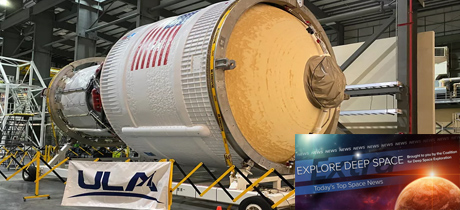In Today’s Deep Space Extra… NASA continuing to prepare the Space Launch System rockets for future Artemis missions. James Webb Space Telescope begins the precise maneuver of lining up the primary and secondary mirrors.
Human Space Exploration
NASA getting SLS megarockets ready for crewed Moon missions
Coalition Members in the News – Aerojet Rocketdyne, Boeing, Northrop Grumman, United Launch Alliance
Space.com (1/12): In a status update posted on Tuesday, NASA officials wrote that the agency and its manufacturing partners have made “great progress” on putting together the Space Launch System (SLS) rocket for Artemis II, a crewed Moon-orbiting mission targeted to lift off in 2024. Testing and manufacturing of SLS parts is also underway for the Moon-landing Artemis III mission, now slated for no earlier than 2025, and its successor Artemis IV, the agency said. “The Space Launch System team is not just building one rocket, but manufacturing several rockets for exploration missions and future SLS flights beyond the initial Artemis launch,” John Honeycutt, SLS program manager at NASA’s Marshall Space Flight Center in Alabama, said in the update.
NASA holding out hope for first SLS launch in March
SpaceNews.com (1/13): On January 5, NASA said it expected to roll out the SLS to Launch Complex 39B in mid-February for a wet dress rehearsal. After the wet dress rehearsal, the SLS will go back to the Vehicle Assembly Building (VAB) for final preparations before returning to the pad for launch. “We’re going to be looking at a wet dress rehearsal sometime next month,” Janet Petro, director of the Kennedy Space Center, said in a talk at SpaceCom January 12. While not offering a date for the Artemis I launch, a slide she presented of major KSC missions in 2022 showed both the wet dress rehearsal and the Artemis I launch taking place in the first quarter of the year. A March launch would need to take place between the 12 and 27, agency officials said in October. The next launch window would be between April 8 and 23.
Space Science
James Webb Space Telescope begins lining up its golden mirrors
Space.com (1/13): Launched Christmas Day, the James Webb Space Telescope (JWST) just days ago successfully completed the deployments of its solar panels, large sunshade and primary and secondary mirrors as it travels toward its L2 Sun/Earth Lagrange point to begin observations. Next up, however, is the precise alignment of the segments that make up the primary and secondary mirrors that will capture the light from the distant universe and provide focus. The alignments will take about 30 days.
NASA to start astrophysics probe program
SpaceNews.com (1/12): NASA will proceed with a new class of astrophysics mission probes intended to lay scientific groundwork for future larger space observatories, Paul Hertz, the agency’s astrophysics division director, told a virtual American Astronomical Society (AAS) town hall this week. The plan follows a recommendation outlined in the latest astrophysics decadal survey called Astro2020 and released in November. The first of the new class of missions, estimated to cost about $1.5 billion, could come together by 2025.
The search for ET has an X-Factor: the evolution of stars
Wired.com (1/12): Just 32 light years from Earth, a young red dwarf star, AU Microscopii, has served as a laboratory for a University of California at Riverside-led study of how a region around the star where life might emerge and called the “habitable zone” evolves over time. The study published in The Astronomical Journal suggests the zone moves and may not remain habitable all that long.
Other News
Pentagon warns hundreds of programs in limbo until Congress passes full-year budget
SpaceNews.com (1/12): In remarks before the U.S. House Appropriations Committee, the Chief of Space Operations, Gen. John Raymond warned that procurements of military satellites and launch services have been placed on hold due to the lack of a full 2022 fiscal year budget agreement. The 2022 fiscal year got underway on October 1, without a yearlong budget appropriation. Overall spending is currently limited to 2021 appropriations through February 18 under a continuing resolution (CR). Current legislation restricts the initiation of new initiatives and the curtailment of programs deemed no longer necessary.
Senior rocket scientist Somanath is new ISRO chairman
The Times of India (1/12): The Indian Space Research Organization (ISRO), India’s space agency, has a new chair. S Somanath, a senior rocket scientist, replaces K SivanI with a goal of boosting India’s presence in space.
On this day in space! January 13, 1978: NASA hires its first female astronauts
Space.com (1/13): On January 13, 1978, NASA selected its eighth class of astronauts which included the first six female astronauts. One of those women, Sally Ride became the first American woman to fly in space in 1983. The class also included Kathryn Sullivan, who would go on to be the first American woman to make a spacewalk.

